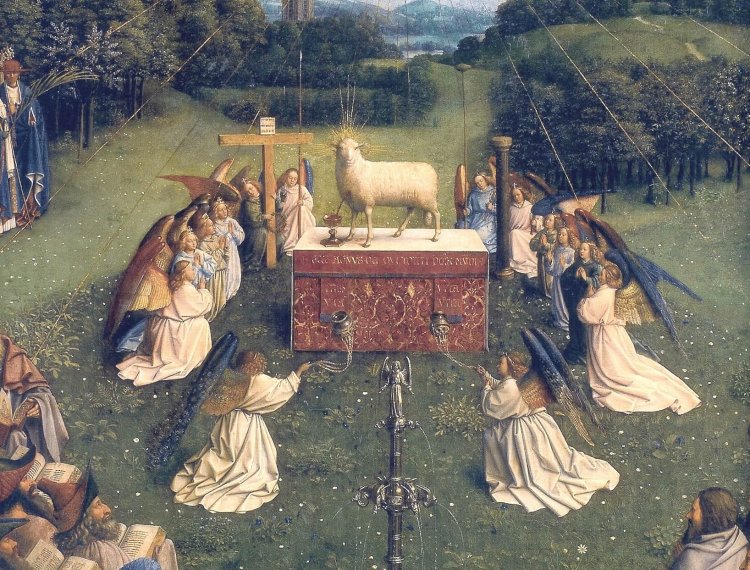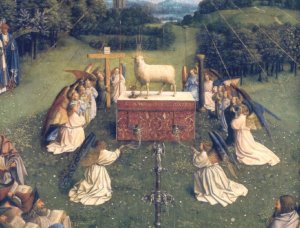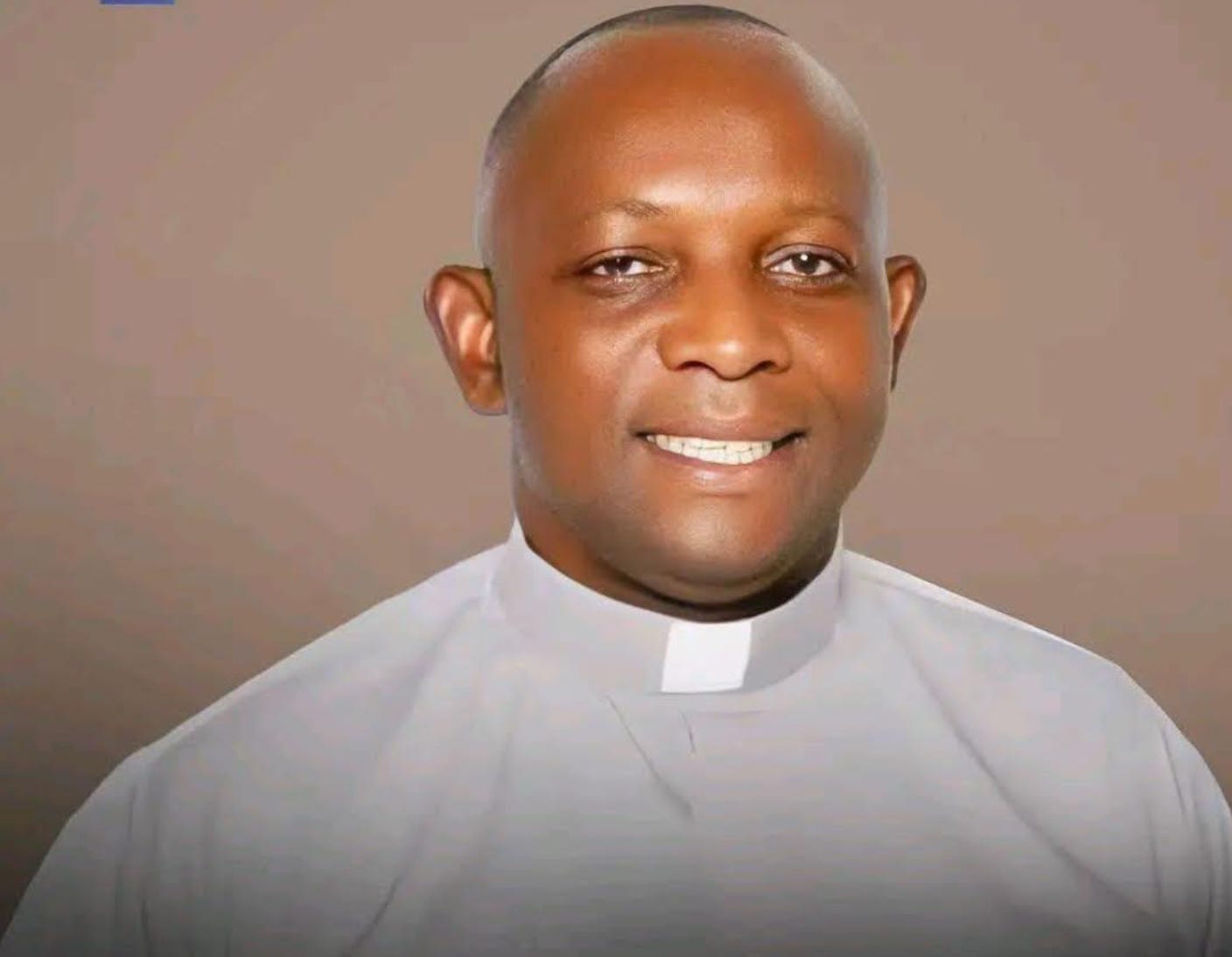Forgotten Customs of the Precious Blood
Above: Adoration of the Mystic Lamb, with gushing blood, detail of the Ghent Altarpiece, Jan van Eyck, c. 1432. The History of the Feast According to the Traditional Catholic Calendar of 1962 and prior, July 1st is the Feast of the […]


Above: Adoration of the Mystic Lamb, with gushing blood, detail of the Ghent Altarpiece, Jan van Eyck, c. 1432.
The History of the Feast
According to the Traditional Catholic Calendar of 1962 and prior, July 1st is the Feast of the Most Precious Blood of Our Lord Jesus Christ. This feast was instituted for the Universal Church in 1849 by Pope Pius IX and was raised to the rank of a double of the first class by Pope Pius XI on the occasion of the nineteenth centenary of our Savior’s death in 1933.
This Feast, like so many others, has fallen victim to the post-Vatican II Church’s novelties. While only established in 1849, this relatively recent feastday is worth honoring and considering after having completed the month of June, which is dedicated to the honor of the Sacred Heart of Jesus.
Fr. Johann Evalgelist Zollner (1883) relates the following history for this importance feastday:
On this day, the Church celebrates the feast of the Most Precious Blood of Jesus Christ. This feast, which had been celebrated in some dioceses since the fifteenth century, on Monday after Trinity Sunday, was extended by Pope Pius IX over the whole Christian world, and its celebration prescribed for the first Sunday of July. The time of persecution and suffering had already begun for the Sovereign Pontiff. Compelled by a revolution to leave Rome, he repaired to Gaeta, in the kingdom of Naples, where he lived in exile for seventeen months, till April 1850. Here it was that on the tenth day of August 1849, he instituted the feast of the Precious Blood.
That most sacred blood is the price of our Redemption and is poured out daily in the Holy Sacrifice of the Mass, whence it flows into the channels of the seven Sacraments, as an atonement for our sins and for our sanctification. For, as in Egypt, God was propitiated by the blood of the paschal lamb, the type and figure of the true Lamb of God, so He is propitiated by the blood of his Son, the true Paschal Lamb, which speaketh better than Abel’s. Herein is the strongest evidence of the infinite love of Jesus Christ, who not only once, but seven times, shed his precious blood amidst the most cruel sufferings for our salvation. Let this seven-fold shedding of the precious blood be the subject of our present meditation.
- The first shedding of blood was at His Circumcision
- The shedding of blood in the garden of Olives
- Jesus is scourged. The four Evangelists narrate that Jesus was scourged
- Jesus shed His blood the fourth time, when he was crowned with thorns
- Jesus shed his blood the fifth time, carrying the cross
- Jesus shed his blood the sixth time, when He was crucified
- The seventh and last time Jesus shed His blood was when His side was opened
Thus Jesus shed His precious blood seven times, and the price of these seven sheddings of blood is found in the seven Sacraments, by which we are cleansed from sin and sanctified. These seven sheddings of blood remind us also of the three theological and the four Cardinal virtues; also of the seven virtues opposed to the seven deadly or capital sins, which are infused into us by baptism; also of the seven gifts of the Holy Ghost, which we receive in confirmation, and finally of the seven days of the week, which we should dedicate to the service of God.
The covenant between God and the Israelites was sealed with blood. The new covenant was sealed with the precious blood of Jesus Christ. The covenant between God and men is sealed again as many times as the Holy Sacrifice of the Mass is offered to God. Assist, whenever you can, at the tremendous Sacrifice of the Mass, and frequently receive holy communion.
Customs in Honor of the Precious Blood
Most customs covered in our series have been based in ancient or at least medieval customs which honored the feasts and fasts of the liturgical year. However, due to the relatively recent institution of this feastday, there are not historical customs associated with this feastday in the same way as Corpus Christi, the Assumption, Easter, and other ancient holy days.
However, devotion to the Precious Blood of our Lord stretches back long before the establishment of this July 1st feastday. Devotion to the Precious Blood is connected to devotion to the Passion and Death of Our Lord since through the shedding of His Blood, mankind was redeemed. Consequently, one can say the Church has always honored the Blood of Jesus Christ. Romans 5:9 states, “we are justified by His blood,” and Hebrews 13:12 states, “and so Jesus also, that He might sanctify the people by His blood, suffered outside the gate.” 1 John 1:7 also writes of the Precious Blood: “…and the blood of Jesus Christ, His Son, cleanses us from all sin.” We would do well to meditate on the seven times Christ shed His Precious Blood for our salvation. As Fr. Peter Scott, SSPX reminds us:
The veneration of the Precious Blood of Our Divine Saviour is as old as the Passion in which it was shed. It is founded on the simple doctrine of the Incarnation, namely that the Second Person of the Blessed Trinity took a human nature to Himself, and that this human nature is the human nature of God. We call this the hypostatic union. Every part of Christ’s human nature is united to the second divine Person. This includes his Precious Blood, to which is consequently owed the adoration that is owed to God Himself, that of latria. We consequently do not need any private revelation to tell us about devotion to the Precious Blood, but find it deeply rooted in the deposit of the faith.
Closer to our modern era, devotion to the Precious Blood has been greatly encouraged by St. Gaspar Buffalo, founder of the Congregation of the Precious Blood of Jesus Christ. The feast had been celebrated beforehand by the fathers of the Most Precious Blood on the Friday after the Fourth Sunday of Lent as related by Father Ulrich F. Mueller:
For many dioceses there are two days to which the Office of the Precious Blood has been assigned, the office being in both cases the same. The reason is this: the office was at first granted to the Fathers of the Most Precious Blood only. Later, as one of the offices of the Fridays of Lent, it was assigned to the Friday after the fourth Sunday in Lent. In many dioceses these offices were adopted also by the fourth Provincial Council of Baltimore (1840). When Pius IX went into exile at Gaeta (1849) he had as his companion the saintly Don Giovanni Merlini, third superior general of the Fathers of the Most Precious Blood. Arrived at Gaeta, Merlini suggested that His Holiness make a vow to extend the feast of the Precious Blood to the entire Church, if he would again obtain possession of the papal dominions. The pope took the matter under consideration, but a few days later sent his domestic prelate Jos. Stella to Merlini with the message: ‘The pope does not deem it expedient to bind himself by a vow; instead, His Holiness is pleased to extend the feast immediately to all Christendom.’ This was June 30, 1849, the day the French conquered Rome and the republicans capitulated. The thirtieth of June had been a Saturday before the first Sunday of July, wherefore the pope decreed (August 10, 1849) that henceforth every first Sunday of July should be dedicated to the Most Precious Blood.
We owe the institution of a special feast in honor of the Precious Blood to Pope Pius IX. It was Pope St. Pius X who transferred the feast from the first Sunday of July to July 1st. And it was Pope Pius XI, who raised the rank of the feastday, in commemoration of the 19th centennial of the mystery of the Redemption.
Devotions to the Precious Blood
In honor of the Feast of the Most Precious Blood, and for the month of July which is in a special manner dedicated to the memory of the Precious Blood, the Church has blessed several devotions that we should consider practicing at this time:
- Chaplet of the Most Precious Blood (approved by Pope Pius VII and enriched with indulgences originating back to 1809 and 1815)
- Litany of the Most Precious Blood of Jesus(approved by Pope John XXIII on February 24, 1960 and enriched with an indulgence)
- Offering in Reparation to the Most Precious Blood of Jesus(approved by Pope Pius VII on September 22, 1817, and enriched with an indulgence)
- An Offering of the Precious Blood for Souls
- The Seven Offerings of the Precious Blood (approved by Pope Pius VII and enriched with indulgences originating back to 1817)
We may also consider for our summer reading getting a copy of Devotion to the Most Precious Blood of Our Lord Jesus Christ: The Greatest Devotion of Our Time produced by the Apostolate for the Precious Blood.
The Forgotten Octaves of St. John the Baptist & Ss. Peter and Paul
Besides being the Feast of the Most Precious Blood of our Lord Jesus Christ, July 1st is traditionally the Octave Day of St. John the Baptist while also still part of the Octave of Ss Peter and Paul. It is worth remembering these forgotten Octaves on this day as well.
Conclusion
Fr. Frederick Faber in The Precious Blood write the following meditation most appropriate for this day and every day of July:
The Precious Blood was assumed directly to our Blessed Lord’s Divine Person from His Immaculate Mother… Mary’s blood was the material out of which the Holy Ghost, the Third Person of the Most Holy Trinity, the artificer of Sacred Humanity, fashioned the Blood of Jesus. Here we see how needful to the joy and gladness of our devotion is the doctrine of the Immaculate Conception. Who could bear to think that the matter of the Precious Blood had ever been itself corrupted with the taint of sin, that it had once been part of the devil’s kingdom, that what was to supply the free price of our redemption was once enslaved to God’s darkest, foulest enemy? Is it not indeed an endless daily jubilee to us, that the church has laid upon us as an article of our faith that sweet truth which the instincts of our devotion had so long made a real part of our belief?
Moreover, there is some portion of the Precious Blood which once was Mary’s own blood, and which remains still in our Blessed Lord, incredibly exalted by its union with His Divine Person, yet still the same. This portion of Himself, it is piously believed, has not been allowed to undergo the usual changes of human substance. At this moment in heaven, He retains something which once was His Mother’s…
May Our Lady help us to better honor Her Son’s Precious Blood. And may our devotions and prayers in honor of this forgotten feastday help to establish further customs that traditional Catholics will honor and observe each July 1st for centuries.














